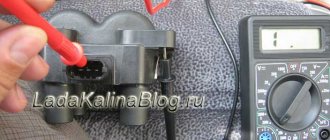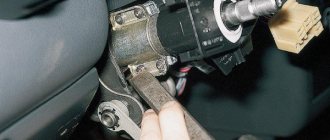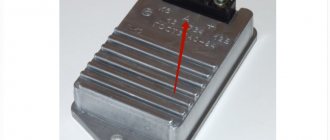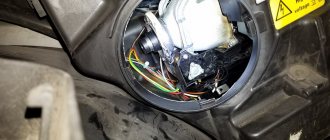The principle of operation of the ignition coil
The ignition coil is the simplest transformer that converts a low voltage current - 12 volts, into a high voltage current - 35,000 volts, which is necessary for a gasoline internal combustion engine to ignite the combustible mixture. From the battery, a low current flows to the primary winding, inside of which there is a secondary winding. Due to the difference in the number of turns and the thickness of the copper wire, a high voltage current arises, which is supplied through a high-voltage wire to the ignition distributor and from there, according to the sequence in the operation of the cylinders, it reaches the spark plugs, where a spark occurs, igniting the combustible mixture.
Ignition coil device
Signs of a faulty ignition coil.
Since the ignition coil is responsible for generating the spark that starts your car's engine, any malfunction will quickly affect the engine's performance. The following symptoms of a faulty ignition coil can be identified:
- The check engine light is on. Since a faulty ignition coil directly affects engine performance, any problem with the ignition coil will cause the check engine light to turn on.
- Increased fuel consumption. When the spark power decreases, the fuel combustion process will not be as efficient, which will lead to a noticeable increase in fuel consumption.
- Shot in the exhaust system. Often an early sign of ignition coil failure is backfire, which occurs when fuel that is not burned in the combustion chamber enters the exhaust system. If this problem is not corrected, the exhaust system may suffer significant damage.
- Stopping the engine. A faulty ignition coil will supply current to the spark plugs intermittently, which can cause the engine to stall. This may also cause the engine to be unable to start.
- Misfires. Due to insufficient power being produced by one or more cylinders, the engine may misfire, especially when accelerating.
- Problems starting the engine. Likewise, if one or more spark plugs are not getting enough charge, the engine will be very difficult to start. Cars with one ignition coil may not start at all in this case.
Differences in Types
There is no particular difference between domestic and imported ignition coils. There is a difference in device types. The main ones are double-spark and single-spark. Individual ignition coils are installed above the spark plug and require the installation of an additional sensor on the camshaft that determines the location of the top dead center. Double-spark coils were previously used for two-cylinder engines and made it possible to eliminate the need for an ignition distributor. On modern models, either two coils are installed, or several coils are combined in one housing. Only suitable for engines with an even number of cylinders. The signs of malfunctions in the coils are exactly the same.
How to identify a faulty ignition coil
The procedure for checking the serviceability of the coil depends on how many ignition coils are in the car. If your car has individual ignition coils, in order to identify the faulty one with a high degree of probability, you can swap the supposedly faulty and known-good coils. If, as a result of this replacement, a spark appears in the cylinder in which there was no spark, and disappears in the other, therefore, the bobbin is truly faulty. In the same way, you can check dual and block coils, but you will have to modify the circuit, which is not always convenient.
Reasons for mechanism failure
There are no specific reasons for ignition coil failure. It should be enough for at least 60–80 thousand kilometers. The coil can work both significantly longer than the period stated by the manufacturer, and much less. The duration of the process of starting the car and the conditions of its use are of great importance. The coil does not like prolonged load, so it is undesirable to turn on the ignition in vain without starting the engine. It can fail if it overheats or gets water inside or on the body.
Main signs and symptoms of failure
The main signs that suggest that the problem lies in the ignition system, and specifically in the coil:
- the engine does not start, although the battery is charged, the starter operates;
- Unstable engine operation, “troits”. This is reflected especially clearly on the tachometer;
- when you sharply press the gas pedal, the engine begins to choke, and significant failures in operation are felt;
- with increased air humidity or rain, uneven engine operation becomes more noticeable and “troits” are much stronger;
- during cold weather, until the engine warms up, failures in engine operation and unstable operation are observed; after heating, the symptoms do not disappear, but become less noticeable;
- during unstable engine operation, the check engine warning light lights up on the dashboard, which during diagnostics will indicate problems in the operation of the ignition coil;
- after acceleration, when switching to higher gears, dips are felt;
- while driving, when you press the accelerator pedal, noticeable jerks are felt;
- When driving, you get the feeling that someone is holding the car from behind, preventing you from accelerating and developing the required speed.
Determining the causes of the malfunction visually
Regardless of the ignition coil installed on the vehicle, any diagnosis must begin with a visual inspection.
- The coil body and contacts must be checked. You need to make sure that the case is in good condition, there are no cracks, chips, black spots or places of partial burnout. It is necessary to wipe the housing, make sure there are no traces of oil leaks or signs of leakage of the housing. If any of the listed defects are detected, no further diagnostics are required. The ignition coil cannot be repaired. It's just being replaced.
- After this, you need to check the status of the contacts. Oxidized terminals must be cleaned and returned to normal operating condition. Poor contact affects the correct operation of the engine and leads to failure of the ignition coil.
If the malfunction can be identified visually, there is no point in looking for the cause inside the mechanism; change the coil without hesitation
How to check the ignition coil: diagnostics and symptoms of failure
The easiest way to do this, of course, is not with your own hands, but with someone else’s hands at the service. But we still need to get there. If the car completely refuses to start, then, among other reasons, the ignition coil may be to blame. If the driver has an error scanner or a diagnostic adapter for diagnostics with data transmission using Bluetooth technology, great.
To do this, you need to have a special application installed on your smartphone and then you can establish with a high degree of accuracy that the reason lies precisely in the coil.
Here are the main error codes that indicate malfunctions in the ignition system of the injection eight-valve VAZ-2114:
- P3000-3004 - no spark in the cylinder (extreme number), these codes will not say anything specific, but will hint where to look for the cause;
- P0351 is a typical error indicating a break in the module on the windings of the first and fourth cylinders;
- P0352 - the same break, but on the windings of the other two cylinders, the second and third.
This is all that a scanner, module or special application can say. Not every one of these codes indicates that it is time to throw away the coil; sometimes the reason may not be so much in the coil as in high-voltage wires or spark plugs.
Breakdown on the spark plug insulator
That is why, before checking the ignition coil on a VAZ-2114, you should go from simple to more complex.
Price of the VAZ-2114 ignition coil and its replacement
The simplest thing is to replace the coil. Even a schoolboy can handle this. For the second Samara you need to buy a new ignition module 43 3705 . The same coil is used on dozens, on Priors and on 1118 with injection eight-valve engines.
Diagnostics of cars without electronics
If a visual inspection does not reveal any defects, then one of the ignition coil windings may be short-circuited. It is necessary to check the integrity of the windings.
- To do this, remove the ignition distributor cap and turn the crankshaft until the contacts of the distributor are closed.
- After this, we bring the high-voltage wire from the ignition coil to the ground of the car. The distance from the end of the wire to the ground should be 5–6 millimeters.
- After this, turn on the ignition. If the ignition coil is working properly, then a bright spark will flash where the wire approaches ground. If there is no spark or appears but is very weak, the problem is in the ignition coil.
This method is only possible for cars that do not have electronics. Control units, electronic fuel injection, and other modules and systems may fail with this test method!
How to check using a VAZ as an example (video hint)
Checking the ignition coil with a multimeter
Typically, a multimeter is found in the garage of most car enthusiasts.
How to make a call: general principles of operation + video
Using a multimeter, check for a short in the ignition coil windings. When working with the device, you need to know the technical characteristics of the ignition coil, because mechanisms from different manufacturers have different technical indicators.
- The first is checking the primary circuit for the presence of a short circuit in the interturn space. We connect the multimeter, having previously set it to measure resistance, to the ends of the primary winding, that is, to the terminals of the ignition coil. Compare the obtained result with the indicators specified in the technical specifications. If the device shows zero, it means that a short circuit has definitely occurred in the primary winding. If the device readings tend to infinity, it means that the circuit has broken. If the results are positive, check the secondary winding.
- To do this, connect the multimeter to the positive terminal of the coil, and connect the other end to the outlet of the high-voltage wire. Compare the results obtained with the characteristics of the ignition coil.
Determining the serviceability of an individual coil (with video guide)
The principle of checking ignition coils installed above the spark plugs is similar to the general one, with the exception of the multimeter connection points. When connecting a device to test the primary circuit, connect to pins of connectors 1 and 3. Polarity does not matter. Further technology completely coincides with testing on a two-spark coil.
To check the secondary winding, connect the device, observing the polarity. The red probe should be in contact with the spring inside the head of the rubber cap, and the black probe should be connected to the second contact of the connector, that is, the middle one. If there is no reading, you must ensure that the spring is in good condition, not dirty, not oxidized, and has normal contact with the coil. If necessary, you can remove the rubber cap and attach the probe directly to the ignition coil contact. Next, check the technical characteristics of the part.
Diagnostics of ignition coils with a multimeter should only be carried out on a cold car. As the coil heats up, the resistance readings change.
How to determine a malfunction and identify a fake ignition coil
Mechanical damage to the insulator, damage to the cylinder head, or oil penetration into the ignition coil will cause the coil to become unusable.
Pollution. If moisture, dirt or road chemicals get on the primary or secondary winding of the coil, it will lead to oxidation of the winding, corrosion and reduced efficiency of the coil and spark plug.
Overheat. Ignition coils are on average designed for temperatures up to 80-100 C. An individual ignition coil fails at temperatures above 230 C, and a housing coil – at 130 C.
Damage to the spark plug or cable.
If the spark plug or patch cord is damaged and receives additional resistance, the ignition coil output voltage rises sharply and a short circuit occurs. After a short circuit, the coil's output voltage may drop, causing a misfire, or the coil may stop producing any voltage at all. The coil insulation becomes damaged if the power output exceeds 50,000 volts.
Cracks in the spark plug connector result in loose spark plug installation and reduced ignition efficiency. If the ignition cable is damaged, the coil does not receive the necessary 12 Volts from the car battery. The coil takes longer to charge, which can cause damage to the ignition module and coil.
Signs of a faulty ignition coil.
Reverse exhaust. If the ignition coil is damaged, the air-fuel mixture does not burn completely in the chamber, and the unburned fuel is discharged through the exhaust system. There is black smoke and the smell of gasoline. Unburnt fuel can damage the exhaust system, resulting in the need for repair or replacement. Problem starting the engine. If the engine does not start, but the spark plugs are fine, the wires that supply voltage from the ignition coil to the spark plug may be damaged. Increased fuel consumption. When the spark plug doesn't receive the voltage it needs, the vehicle uses more fuel to compensate for the lack of ignition power. The car coughs and vibrates. If the car vibrates, coughs and sneezes when driving and idling, this may be a sign of a faulty ignition coil.
How to test the ignition coil with a multimeter and ohmmeter.
The main problems with the ignition coil are damage to the insulating material, damage to the contacts and short circuit. If it is suspected that the ignition coil is faulty, the ability to transform the voltage of the coil is checked with a multimeter or ohmmeter. The obtained values are compared with the manufacturer’s indicators, and if they do not match, the coil is considered faulty. To check the primary winding resistance, measure the resistance between the positive and negative terminals of the ignition coil. The value should be between 0.5-3 ohms. To check the resistance in the secondary winding, measure the resistance between the positive terminal and the coil output.
Important! Do not check the serviceability of the coil by the presence of a spark between the spark plugs and the car body. This is a sign of damage to the coil and electronic devices.
The performance of the coil can be checked with a pick-up tool (device with a magnet). As the coil charges and discharges, the magnetic field around the coil changes. If you bring a magnet close to a working ignition coil, the magnet will begin to move due to the changing magnetic field. The ignition coils have failed due to a short circuit, then when you connect a multimeter to the positive and negative contacts of the coil, the readings will greatly exceed the values specified class=”aligncenter” width=”502″ height=”511″[/img] Determination of resistance primary (1) and secondary (2) windings.
Signs of a fake.
Counterfeits are less efficient, fail faster, misfire, and are less heat resistant. Visible signs.
1. The reel body is made of low-quality material; seams and foreign inclusions in the body material are visible.
2. A special mixture is introduced inside the coil body for sealing. In the original ignition coil, the mixture should be homogeneous in appearance, without any foreign substances or bubbles. The presence of air in the secondary winding leads to corrosion on the coil body.
3. The primary and secondary winding housing should not be disconnected.
Internal differences. In the original ignition coil, the wires and winding components are arranged in an orderly manner.
Tips on storage and transportation conditions:
Avoid getting moisture, dirt and other contaminants on the ignition coil housing - this can lead to corrosion of the contacts and windings of the ignition coil. When transporting ignition coils, do not allow them to fall, mechanical loads (do not place a load on the packaging), or allow water or moisture to enter the coil body.











